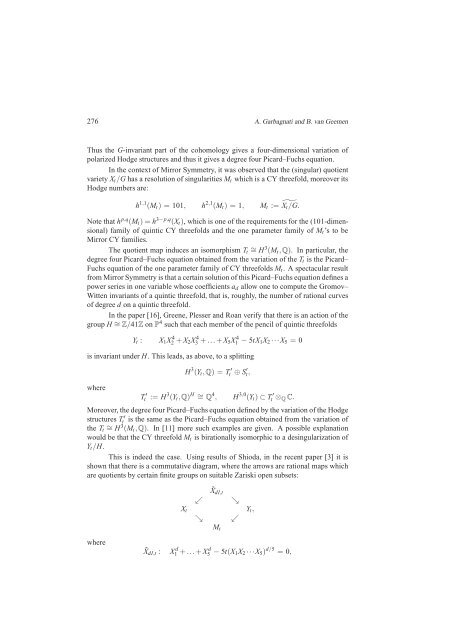Examples of Calabi-Yau threefolds parametrised by Shimura varieties
Examples of Calabi-Yau threefolds parametrised by Shimura varieties
Examples of Calabi-Yau threefolds parametrised by Shimura varieties
Create successful ePaper yourself
Turn your PDF publications into a flip-book with our unique Google optimized e-Paper software.
276 A. Garbagnati and B. van GeemenThus the G-invariant part <strong>of</strong> the cohomology gives a four-dimensional variation <strong>of</strong>polarized Hodge structures and thus it gives a degree four Picard–Fuchs equation.In the context <strong>of</strong> Mirror Symmetry, it was observed that the (singular) quotientvariety X t /G has a resolution <strong>of</strong> singularities M t which is a CY threefold, moreover itsHodge numbers are:h 1,1 (M t ) = 101, h 2,1 (M t ) = 1, M t := ˜X t /G.Note that h p,q (M t )=h 3−p,q (X t ), which is one <strong>of</strong> the requirements for the (101-dimensional)family <strong>of</strong> quintic CY <strong>threefolds</strong> and the one parameter family <strong>of</strong> M t ’s to beMirror CY families.The quotient map induces an isomorphism T t∼ = H 3 (M t ,Q). In particular, thedegree four Picard–Fuchs equation obtained from the variation <strong>of</strong> the T t is the Picard–Fuchs equation <strong>of</strong> the one parameter family <strong>of</strong> CY <strong>threefolds</strong> M t . A spectacular resultfrom Mirror Symmetry is that a certain solution <strong>of</strong> this Picard–Fuchs equation defines apower series in one variable whose coefficients a d allow one to compute the Gromov–Witten invariants <strong>of</strong> a quintic threefold, that is, roughly, the number <strong>of</strong> rational curves<strong>of</strong> degree d on a quintic threefold.In the paper [16], Greene, Plesser and Roan verify that there is an action <strong>of</strong> thegroup H ∼ =Z/41Z onP 4 such that each member <strong>of</strong> the pencil <strong>of</strong> quintic <strong>threefolds</strong>Y t : X 1 X 4 2 + X 2 X 4 3 +...+ X 5 X 4 1 − 5tX 1 X 2···X 5 = 0is invariant under H. This leads, as above, to a splittingwhereH 3 (Y t ,Q) = T ′t ⊕ S ′ t ,T ′t := H 3 (Y t ,Q) H ∼ = Q 4 , H 3,0 (Y t )⊂T ′t ⊗ Q C.Moreover, the degree four Picard–Fuchs equation defined <strong>by</strong> the variation <strong>of</strong> the Hodgestructures T t′ is the same as the Picard–Fuchs equation obtained from the variation <strong>of</strong>the T t∼ = H 3 (M t ,Q). In [11] more such examples are given. A possible explanationwould be that the CY threefold M t is birationally isomorphic to a desingularization <strong>of</strong>Y t /H.This is indeed the case. Using results <strong>of</strong> Shioda, in the recent paper [3] it isshown that there is a commutative diagram, where the arrows are rational maps whichare quotients <strong>by</strong> certain finite groups on suitable Zariski open subsets:˜X dI,tւ ցX t Y t ,ց ւM twhere˜X dI,t : X d 1 +...+ X d 5 − 5t(X 1X 2···X 5 ) d/5 = 0,














